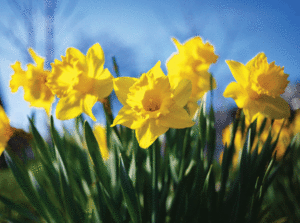Boxwood Twig Blight! The fungus Cylindrocladium pseudonaviculatum first presents itself as leaf spot followed by rapid browning and leaf drop starting on the lower branches and moving upward in the canopy.
The fungus can remain in fallen leaves, so be sure to rake up fallen twigs and throw away (do not compost). 
Research is still being conducted to find a solution to get rid of this fungus.
Ridding the plant of diseased branches and raking up all dropped leaves is the best prevention.
WEEK ONE
• You will have bigger blooms and more of them if you fertilize your spring flowering bulbs after they are finished blooming. I suggest using Espoma’s Bulb-tone at a rate of 4-6 pounds for every 100 square feet.
• Prune and shape up crape myrtles you wish to grow as trees before they bloom. Remove any dried flower clusters or seed pods. To encourage a canopy to form, remove the branches a third of the way up the trunk. Always remove any branches rubbing across others and any growing into the center of the canopy. Always prune unbranched limbs back to an outward facing bud. Also, remember crape myrtles are slow to wake-up in the spring. If you feel that your plant has died, wait until late next month before deciding whether to replace it.
WEEK TWO
• In late April, lift and divide the roots of last year’s garden mums. Discard the old centers and plant the young roots in new places. You will get a better show than if you left them in the same place for years on end.
• Mowing begins in earnest this month. Keep the blades on your mower sharp; a clean cut is a healthy cut. Set your mower to cut tall type fescue at 3 inches. Mow often enough so you never have to cut off more than a third of the grass to maintain a 3-inch height.
WEEK THREE
• To solve compaction of the lawn, avoid thatch buildup, and condition the soil, aerate every two or three years. Aerating equipment punches 2- to 3-inch deep holes in the soil and allows fertilizer, air, and water to penetrate.
• Prune azaleas as they finish blooming to a shape that offers a layering look, rather than just shearing off the branch tips. We also suggest using Bonide’s Rose and Flower or VPG’s Azalea and Flower with systemic. Both products promote strong roots and beautiful blooms, while protecting the plant against insect damage for up to 8 weeks.
WEEK FOUR
• Do not be tempted to cut back the foliage of your daffodils. The bulb uses the leaves to transform energy from the sun to help develop next year’s blossoms. Be sure to leave it until the foliage has turned completely yellow. Apply Bulb-tone as per label instructions now, to promote bigger and more flowers for next season.
• When mulching we suggest using a product called Amaze for prevention of both broadleaf and grassy weeds in the flowerbeds. It is also a great time to apply any needed fertilizers such as Espoma’s Holly-tone or Plant-tone to provide extended feeding of the plants. Be sure to apply all products before mulching to insure that they will stay in place.
(Editor’s Note: Ken Morgan is the owner of Robin’s Nest Floral and Garden Center in Easton, Md.)



